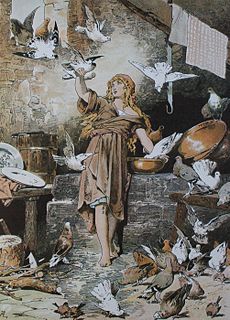
"Cinderella", or "The Little Glass Slipper", is a folk tale with thousands of variants throughout the world. The protagonist is a young woman living in forsaken circumstances that are suddenly changed to remarkable fortune, with her ascension to the throne via marriage. The story of Rhodopis, recounted by the Greek geographer Strabo sometime between around 7 BC and AD 23, about a Greek slave girl who marries the king of Egypt, is usually considered to be the earliest known variant of the Cinderella story.

"Sleeping Beauty", or "Little Briar Rose", also titled in English as "The Sleeping Beauty in the Woods", is a classic fairy tale about a princess who is cursed to sleep for a hundred years by an evil fairy, to be awakened by a handsome prince at the end of them. The good fairy, realizing that the princess would be frightened if alone when she awakens, uses her wand to put every living person and animal in the palace asleep, to awaken when the princess does.
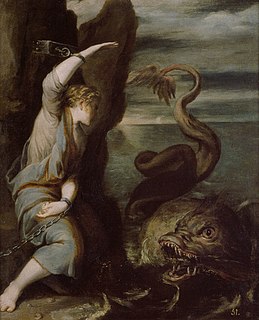
Princess and dragon is a archetypical premise common to many legends, fairy tales, and chivalric romances. Northrop Frye identified it as a central form of the quest romance.

In fairy tales, a fairy godmother is a fairy with magical powers who acts as a mentor or parent to someone, in the role that an actual godparent was expected to play in many societies. In Perrault's Cinderella, he concludes the tale with the moral that no personal advantages will suffice without proper connections.
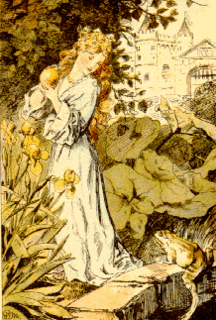
"The Frog Prince; or, Iron Henry" is a German fairy tale collected by the Brothers Grimm and published in 1812 in Grimm's Fairy Tales. Traditionally, it is the first story in their folktale collection. The tale is classified as Aarne-Thompson type 440.
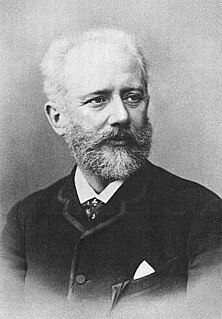
The Sleeping Beauty is a ballet in a prologue and three acts, first performed in 1890. The music was composed by Pyotr Ilyich Tchaikovsky. The score was completed in 1889, and is the second of his three ballets. The original scenario was conceived by Ivan Vsevolozhsky, and is based on Charles Perrault's La Belle au bois dormant. The choreographer of the original production was Marius Petipa.
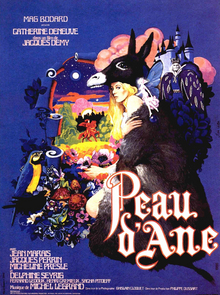
Donkey Skin is a 1970 French musical fantasy comedy film directed by Jacques Demy, based on Donkeyskin, a fairy tale by Charles Perrault about a king who wishes to marry his daughter. It stars Catherine Deneuve and Jean Marais, with music by Michel Legrand. Donkey Skin proved to be Demy's biggest success in France, with a total of 2,198,576 tickets sold.

Cendrillon (Cinderella) is an opera—described as a "fairy tale"—in four acts by Jules Massenet to a French libretto by Henri Caïn based on Perrault's 1698 version of the Cinderella fairy tale.

"The Blue Bird" is a French literary fairy tale by Madame d'Aulnoy, published in 1697. An English translation was included in The Green Fairy Book, 1892, collected by Andrew Lang.

"Katie Woodencloak" or "Kari Woodengown" is a Norwegian fairy tale collected by Peter Christen Asbjørnsen and Jørgen Moe in Norske Folkeeventyr. Andrew Lang included it in The Red Fairy Book.
The Princess Mayblossom is a French literary fairy tale written by Madame d'Aulnoy in 1697. Andrew Lang included it in The Red Fairy Book.
"The Pig King" or "King Pig" is an Italian literary fairy tale written by Giovanni Francesco Straparola in his The Facetious Nights of Straparola. Madame d'Aulnoy wrote a French, also literary, variant, titled Prince Marcassin.
The White Doe or The Doe in the Woods is a French literary fairy tale written by Madame d'Aulnoy. Andrew Lang included it in The Orange Fairy Book.
The Child who came from an Egg or The Egg-Born Princess is an Estonian fairy tale, collected by Dr. Friedrich Reinhold Kreutzwald in Eestirahwa Ennemuistesed jutud.
King Kojata or The Unlooked for Prince or Prince Unexpected is a Slavonic fairy tale, of Polish origin. Louis Léger remarked that its source was "one of the most important collections of Polish literature".
Finette Cendron is a French literary fairy tale written by Madame d'Aulnoy.
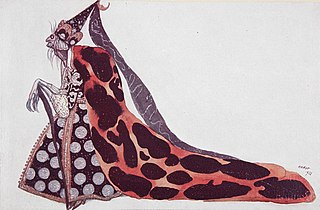
The Wicked Fairy Godmother or the Wicked Fairy, a rare figure in fairy tales, is nevertheless among the best-known figures from such tales because of her appearance in one of the most widely known tales, Sleeping Beauty, and in the ballet derived from it. Anonymous in her first appearance, she was later named in some variants Carabosse and is called Maleficent in Walt Disney media.
The Imp Prince is a French fairy tale written by Marie Catherine d'Aulnoy and published in her book Fairy Tales in 1697.
Bearskin is a French literary fairy tale by Marie-Madeleine de Lubert. It was included in her revised edition, published in 1753, of Henriette-Julie de Murat's last novel, Les Lutins du château de Kernosy, which is why it is often attributed to Madame Henriette-Julie de Murat.










